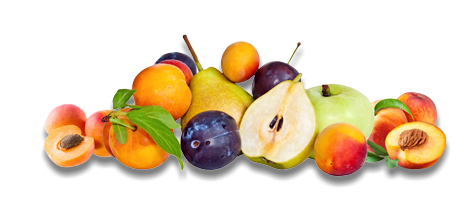What's in Season
Summer Stonefruits grown in the Riverland, South Australia are harvested between October and April each year. Varieties consist mainly of Peaches, Nectarines, Plums and Apricots. Summer Stonefruits are rich in vitamins A, C and E and a great source of dietary fibre and potassium.
Peaches
The peach originated in China where it has been cultivated for thousands of years and is regarded as the ‘tree of life’. Known as Persian Apples by the Romans and introduced to America by Columbus, the fruit has been produced in Australia since the 19th Century. Peaches bruise easily so look for smooth, unblemished fruit and handle them with care. When ripe, a peach should produce a delectable full-bodied aroma from the stem and start to lose its brightness.
A good sign of how sweet they are is the presence of white freckles on the top half. White peaches, like white nectarines, can be eaten sweet and crunchy. Peaches are a fantastic any-time snack and great sliced up in fruit or vegetable salads, pies, flans or on top of cheesecakes and pavlovas. They are also brilliant for jams and chutneys and go well with chicken, pork and fish.
Nectarines
Nectarines, or ‘nectar of the Gods’, are a variety of peach with a smooth yellow, orange or red skin and either white or yellow flesh. Originating in China some 4000 years ago, they are ready to eat when they start going a little dull and you can smell a sweet fragrance coming from the fruit.
Yellow nectarines are great soft and juicy and will yield slightly to gentle palm pressure and be both sweet and tart. They usually start off with a slightly acidic flavour while their white counterparts have low acidic levels meaning they’re sweet even when they’re firm and crunchy. Both varieties get sweeter and juicer as they soften and white speckles near the stem of the fruit are the best indicator of this.
Sliced nectarines are excellent in salads and on cheese and fruit platters.
Plums
Plums are far more diverse than their summer stonefruit relatives coming in a wider range of shapes, sizes, skin colours and tastes which vary from extremely sweet to quite tart. Some plum varieties are specifically bred so they can be dried and still retain their sweetness and these are used for prunes.
When selecting, go for plump, full-coloured plums. They generally become dull just before they are ready to eat.
Plums add a sweet surprise to hot and cold desserts, stewed, grilled or baked, and in fruit salads or pies. They also make tasty sauces for various meats or ice-cream and can also be preserved in jams.
Apricots
In Latin, apricot means ‘precious’, a label earned because it ripens more quickly than other summer fruit. Originally from China, cuttings of this golden fruit made their way across the Persian Empire to the Mediterranean where they flourished. Spanish explorers introduced the fruit to California and in 1792 the first major production of apricots was recorded.
Apricots should be deep yellow or yellow/orange, plump, well-formed and fairly firm. Their characteristic flavour and sweetness develops on the tree. Delicious fresh, they are also fabulous in desserts, poached, stewed or pureed, and in chutneys, pickles, compotes, salads and sorbets. They also pair up well with meats and poultry.

Summerfruit SA
Formally South Australian Fresh Fruit Growers Association – is pleased to welcome you to our website. Our endeavour is to encourage everyone to eat more delicious summer stonefruit by providing you with as much information as possible on how to source, buy, store and cook tasty summer stonefruits grown in the Riverland.
Summerfruit SA © 2019 | Disclaimer | Created by Pippos Technology Solutions


